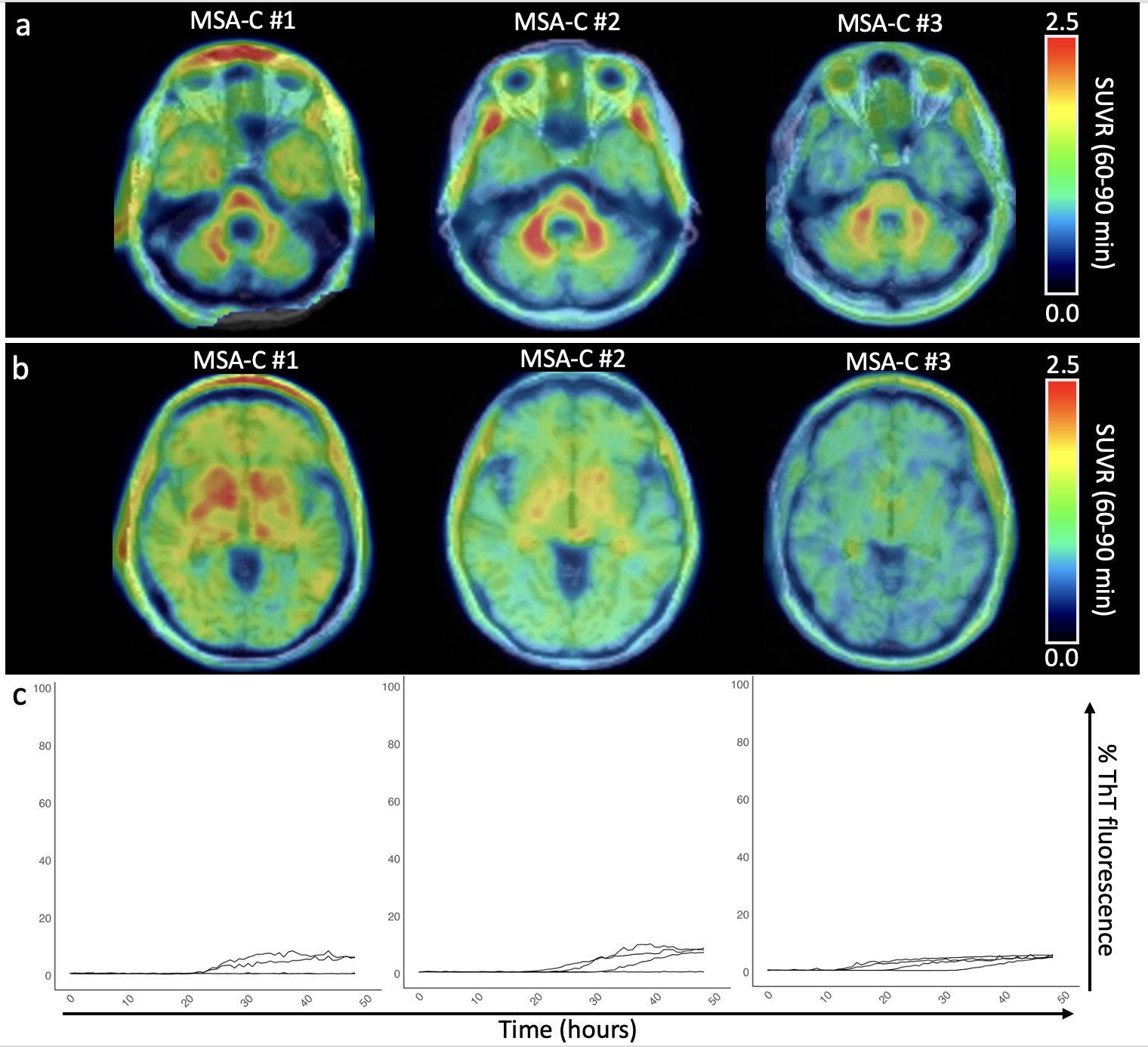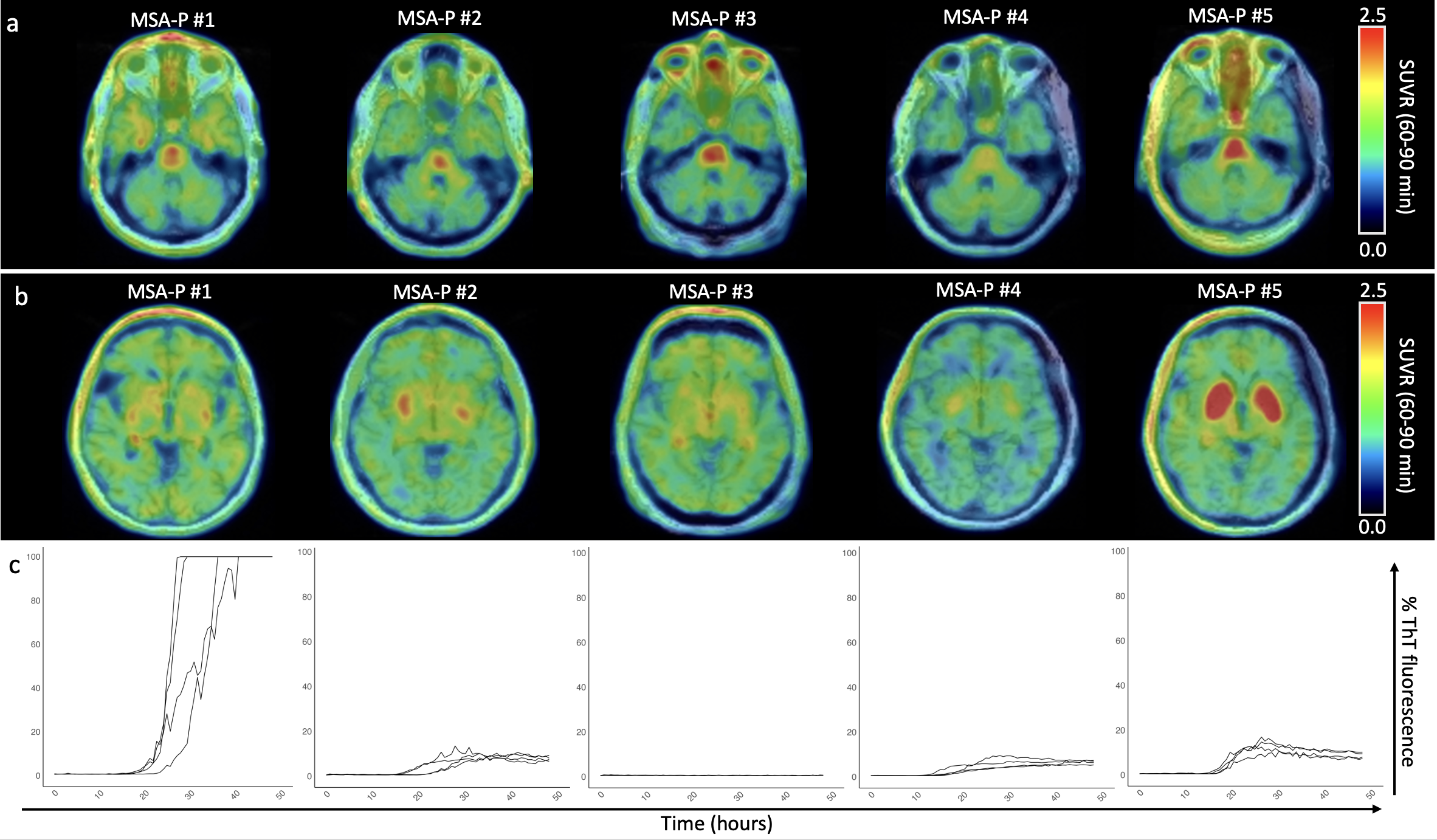Category: Parkinsonism, Atypical: MSA
Objective: To determine whether the combination of spatial (PET [18F]ACI-12589) and conformational (skin seed amplification assay; SAA) a-syn data aids the early differential diagnosis of MSA-P.
Background: It is challenging to diagnose MSA early and specifically because the presentation can overlap with other neurodegenerative diseases. Recently, the [18F]ACI-12589 PET tracer has shown promise in visualizing the a-syn pathology in MSA patients. In parallel, α-syn seed amplification assays (SAA) have demonstrated distinct aggregation kinetics in MSA versus PD.
Method: Eight subjects who met the 2022 MDS diagnostic criteria for probable MSA (MSA-P = 5, MSA-C = 3) were enrolled. Subjects underwent scans 60–90 min after injection of 305 ± 39 MBq [18F]ACI-12589. PET images were motion-corrected and co-registered to MRI. Regions of interest (ROIs) were defined using the Automated Anatomical Labeling (AAL) atlas or manually delineated for the medial cerebellar peduncles (MCP). Three 5-mm skin biopsies were obtained in all subjects. The SAA reaction buffer included 1 mg/mL recombinant α-syn, 500 µM NaCl, 100 mM PIPES, 10 µM thioflavin T (ThT), and 2µl of 0.5% skin biopsy lysate. Four replicates per sample were incubated at 37°C for 48 hours. Samples were positive if ≥75% of the replicates crossed a predefined fluorescence threshold.
Results: All MSA-C cases showed [18F]ACI-12589 uptake in the MCP and had at least one positive SAA with an MSA pattern [Fig.1]. Among the five clinically probable MSA-P cases, two (MSA-P #2 and #5) had a faintly increased uptake in the MCP and a strong signal in the basal ganglia [Fig. 2]. These two also had a clear MSA pattern on SAA, as did one other case (MSA-P #4). The two remaining MSA-P subjects did not show retention with [18F]ACI-12589 PET and either a PD pattern in SAA (MSA-P #1) or a consistently negative SAA (MSA-P #1). Upon clinical re-evaluation, the diagnosis of MSA-P #1 was changed to PD, while a non-synucleinopathy diagnosis is being considered for MSA-P #3.
Conclusion: While the a-syn [18F]ACI-12589 PET tracer is sufficient for the diagnosis of MSA-C, the combination of both spatial (PET) and conformational (seeding amplification) α-syn biomarkers will improve the error-prone clinical differential diagnosis of MSA-P. These biomarkers promise to open up new precision medicine approaches for this devastating disease.
PET SUVR and corresponding skin SAA in MSA-C cases
PET SUVR and corresponding skin SAA in MSA-P cases
To cite this abstract in AMA style:
D. Rodriguez Gomez, B. Changizi, C. Sandiego, A. Green, A. Kuzkina, J. Alexander, O. Laun, K. Jones, D. Ceku, J. Meehan, S. Perumalla, S. Rai, A. Knorr, V. Hliva, M. Kosco-Vilbois, A. Pfeifer, N. Mendonca, D. Russell, F. Capotosti, V. Khurana. Combining alpha-synuclein PET and seeded amplification assays to improve the diagnostic accuracy of Multiple System Atrophy of the Parkinsonian subtype (MSA-P) [abstract]. Mov Disord. 2024; 39 (suppl 1). https://www.mdsabstracts.org/abstract/combining-alpha-synuclein-pet-and-seeded-amplification-assays-to-improve-the-diagnostic-accuracy-of-multiple-system-atrophy-of-the-parkinsonian-subtype-msa-p/. Accessed December 28, 2025.« Back to 2024 International Congress
MDS Abstracts - https://www.mdsabstracts.org/abstract/combining-alpha-synuclein-pet-and-seeded-amplification-assays-to-improve-the-diagnostic-accuracy-of-multiple-system-atrophy-of-the-parkinsonian-subtype-msa-p/


